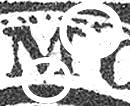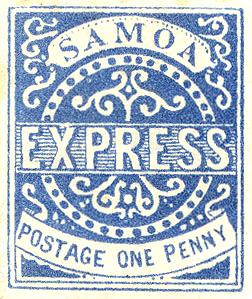|
THIS IS A SPECIAL FEATURE OF THE
PHILATELIC EXPERTS WEB SITE,
INCORPORATING THE STAMP FORGERY GUIDE.
Its first section lists the names and areas of 1
750 stamp experts, past and present,
who have back-stamped or signed stamps.
Venezuela 1896 Miranda map stamp
forgeries.
Please visit the site's
main page with
introduction and site map.
The Samoa Express
stamps are one of the most frequently encountered forgeries and private reprints amongst
all the world's stamps. Actually the genuine stamps are rarer than the
catalogue prices indicate, because the seemingly endless volume of forgeries
and reprints has most likely suppressed demand for and interest in the
genuine items. Some information on how to identify these stamps could be
useful,
and therefore this guide has been published. (Images at
the foot of the page. Quick
checklist.)
The Samoa Express private post was set up in 1877 and closed in August 1881.
In 1882 "remainders" of the stamps (550 to 22 500 copies of each of the
eight values, including an unissued 2d
stamp), were sold to a stamp dealer. These unissued remainders are of the fourth
state of the printing stones. They are not reprints nor forgeries,
and had been produced in 1881, but
were dispatched by the printers only just after the
Samoa Express closed. Remainders are notably less common than reprints and
forgeries.
Stamps in states 1 and 2 are so rarely encountered that this study
concentrates on describing the features distinguishing the 3rd and 4th
states, the reprints and the forgeries. Some rough perforated state 3 stamps
were also remaindered, but they had been available for regular sale at the
post office. The 9d exists in the 4th state with rough perforation as an issued and
original stamp too – plating is necessary (see Odenweller, RPSNZ and Barefoot). In
catalogues perforations are usually rounded up to the nearest half. Here
quarter-perforations are quoted.
When the Samoa Express had closed, Whitfield King & Co. obtained the rights to
have reprints made by the original Sydney printers, and soon facsimiles
(more correctly named so, as
they were made from new lithographic printing stones and the sheet size was
larger) began to appear in colossal
quantities. In 1884 25 000 to 50 000
sets were produced, and in 1892 100 000 more sets. According to
Odenweller the value of the reprints are $1 US each. In 1897 the stones
were defaced. But such was the philatelic demand that these postage stamps were also forged on
six occasions.
The different states of the stones* are identified by a constant flaw in the white line above the X
in "express", and by some dots. In the 3rd state a coloured spot in the
white line
above X has been crudely removed causing damage to the line, and the
upper right serif of M has been deformed (latter illustrated below).
The 1s does not exist in state 3. 3rd state stamps were first perforated 12 ¼, and then 11
¾, the latter first clean cut, then
very rough
cut (in which condition they are most often seen). The only state 3 stamp that can have
perforations on all four sides is the 1d, all other state 3 stamps
being imperforated on one or two sides. Many shades.
*Strictly
speaking: of the matrix stone. For the reprints transfers from remainder
sheets were used.
The 4th state (both remainders and reprints) is as state 3, but
with an additional very tiny dot of colour under the middle stroke of the M,
often connected with the thick curved line below, forming a vertical dash.
 On a few stamps the
small characteristics are not clearly visible (beware of scratched out dots
too), but note that if there is even a trace of a dot on this
very spot, then it cannot be a state 3 (or earlier) stamp. A
copy of a reprint is useful as reference when sorting out forgeries. On a few stamps the
small characteristics are not clearly visible (beware of scratched out dots
too), but note that if there is even a trace of a dot on this
very spot, then it cannot be a state 3 (or earlier) stamp. A
copy of a reprint is useful as reference when sorting out forgeries.
– BELOW A GENUINE STAMP (state 3,
position 5 in row 3, final issue):

The Samoa Express
4th state
remainders are perforated 11 ¾ on two, three or four sides, and
moderately clean cut. The gum tends to be streaky and yellowish or brownish,
sometimes darkening the paper. The printing quality of the remainders is
poorer than that of the reprints. The reprints (all of them)
are likewise in state 4. The paper is
similar to the original, but seems whiter. The perforation was first
11 ¾, later 12 ¼, on two, three or four
sides, and clean cut. Sheet size: 40 (8x5). Stamps perforated on all sides are
usually reprints or forgeries (beware of trimmed-off perforations). The gum is smooth and white.
Experience is required to distinguish between remainders and reprints. Odenweller describes the colours
using these terms (Rm remainders, Rp reprints).
Forgery 1 emulates state 3 stamps. It is best recognised by the
pearls or large dots under EX and SS, which are cut by the line under
"express". On all other stamps these pearls stay free, especially at left.
 The top right
serif of M is not bent down and the pearls below M are evenly spaced. The
arabesques are too thin. Further there is no dot or vertical dash below
M. F1 is perforated 11 ¼ on all four
sides (beware of trimmed-off perforations). There are two subtypes of F1: in
one the letters in the value label are small and their shape compares well
with the originals, in the other large. See the
comparison (opens in a new
tab or window). The shades
of colours are also slightly different. Stamps of the first subtype are often
poorly centred. F1 is the Fournier forgery.
Serrane type A, Barefoot 1, Odenweller 3, RPSNZ 2, Earée 1. The top right
serif of M is not bent down and the pearls below M are evenly spaced. The
arabesques are too thin. Further there is no dot or vertical dash below
M. F1 is perforated 11 ¼ on all four
sides (beware of trimmed-off perforations). There are two subtypes of F1: in
one the letters in the value label are small and their shape compares well
with the originals, in the other large. See the
comparison (opens in a new
tab or window). The shades
of colours are also slightly different. Stamps of the first subtype are often
poorly centred. F1 is the Fournier forgery.
Serrane type A, Barefoot 1, Odenweller 3, RPSNZ 2, Earée 1.
Forgery 2 of a Samoa Express stamp resembles the rare undamaged state 1 regarding the line above X, but is,
in addition, easily identified also by the
single large pearl straight under M, as well as below O.
 All other stamps have two
pearls here.
Perforated 11 ½ on all four sides. Serrane type C, Barefoot 2, Odenweller
2, RPSNZ 3,
Earée 2. Reprints, F1's
(both subtypes) and F2's are very common. They are nearly always uncancelled
and the gum has often been washed away. All other stamps have two
pearls here.
Perforated 11 ½ on all four sides. Serrane type C, Barefoot 2, Odenweller
2, RPSNZ 3,
Earée 2. Reprints, F1's
(both subtypes) and F2's are very common. They are nearly always uncancelled
and the gum has often been washed away.
Forgery 3 is very scarce (two copies have been reported). There are many peculiar errors of design: compare the letters
of "express", especially S and R; 18 instead of 16 pearls in the upper band, 15
instead of 14 in the lower, etc. F3 is only known in the 1d denomination.
Odenweller type 4, RPSNZ 4.
Forgery 4 (not illustrated) is also known in only one denomination, the 1d.
State 1. The letters in "postage one penny" are shorter than on the originals and
there is a distinct period after "penny" (this is present in
certain genuine positions too). There is a coloured flaw above S
of "Samoa" and a colourless flaw in the bottom right triangle. The
stamp's outer frame line at right and bottom is thicker. Fortunately this good
forgery is not very common. Serrane type B, Odenweller 1, RPSNZ 1.
Forgery 5 (Odenweller 5) is known in red-brown and in black. Forgery
6 (Odenweller 6) is in the normal blue colour. The denomination of these
two forgeries is 1d, and they closely resemble F4. They are both very rarely
encountered. F3–F6
are ancient forgeries. F4 and F6 are probably printed in typo, all other
forgeries in litho.
Conclusion. For all Samoa Express forgeries there are
several other distinguishing errors, in the design, than those mentioned above.
Compare the illustrations below. Difference in shade is often not a
reliable identifying feature. Forgery type B in Bynof-Smith's manual is not a forgery,
but remainders or reprints. Even without entering into plating one can still
easily separate state 4 reprints and the two main forgeries, and F1 subtypes. This can be interesting
in itself, and occasionally one might sort out a state 3 stamp, a
remainder or an uncommon forgery from a cheap lot. See the
checklist for a simple
sorting procedure.
LITERATURE
Jack R. Hughes.
Plating Samoa Express Facsimiles. Pacific Islands Study Circle (UK) 1997. 91
loose leaf pages.
Robert P. Odenweller. The Stamps and Postal History of Nineteenth Century
Samoa. RPSL & RPSNZ 2004. The definitive work.
The Postage Stamps of New Zealand, volume V. RPSNZ 1967. Pp. 502–549.
R. B. Yardley. The Samoa Express Postage Stamps. RPSL 1916. (Reprinted
c. 1980
by Postilion Publications, a division of Roger Koerber Inc, Southfield
Michigan.)
See also the reference manuals in the Stamp Forgery
Guide.
Copyright ©
2005–2010 by G.
Kock
Contact
information here. Address of this page:
www.filatelia.fi/forgeries/samoa-express.html
Back to top.

|